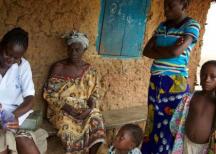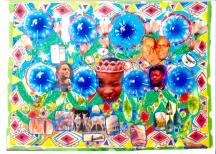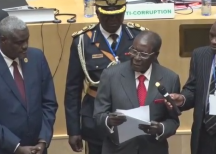
If they must sing about Wambui Otieno, ‘may our children’s songs be a robust tribute to the courageous spirit of a woman who said “sikubali!” to the chauvinist currents of her time,’ writes Grace A. Musila.
SOUNDTRACKS OF OUR YOUTH
As children growing up in 1980s Kenya, one of the songs we sang in our games – accompanied by the intricately co-ordinated palm-tapping that only a child’s flexible hands can master – had the following lyrics:
Wambui kauliza
Otieno yuko wapi?
Wambui kajibiwa
Otieno amekufa
(Wambui asked
Where is (SM) Otieno?
Wambui was answered
Otieno has passed on.)
Wambui kauliza
Atazikwa wapi?
Wambui kajibiwa
Atazikwa Nyalgunga.
(Wambui asked
Where will he be buried?
Wambui was answered
He will be buried in Nyalgunga)
Sikubali!
Mume wangu
Akazikwe
Nyalgunga!
(I don’t accept!
(that) my husband
be buried
(in) Nyalgunga.)
These lyrics were set to the tune of South African musician Yvonne Chaka Chaka’s popular track, ‘Umqombothi’ (‘We maDlamini, Uph’umqombothi?’). At the time, we questioned neither the lyrics nor the tune. Yvonne Chaka Chaka’s music was a popular staple in the Kenyan musical diet; and there was nothing remarkable about the fact that we now had Swahili lyrics for it. Like all the songs of our childhood – or what my friend T.M. Mboya calls ‘the soundtracks of our youth’ – we never wondered who Wambui and Otieno were, or why Wambui would be against burying Otieno in Nyalgunga. What mattered was that the song worked for our games. And so we sang with as much delight as we sang Lokassa ya Mbongo’s ‘Monica’ whose French lyrics our Anglo-Swahili tongues mangled with youthful abandon: ‘Monica ee e ee/jekone pa grigri, jikonepa marabu, selaverite Monica ee e ee’ (‘Je connais pas gris-gris/Je connais pas marabout, c’est la veritè Monica ee e ee’).
Years later, when we read historians Atieno Odhiambo and David Cohen’s excellent book, ‘Burying S.M. Otieno: The Politics of Knowledge and the Sociology of Power’ in Africa (1992); my friends and I revisited the song. With the benefit of adulthood and academic debates about popular culture and the workings of the public sphere, we pondered the dynamics that mediated the case’s journey from the Nairobi courtrooms to children’s clapping hands across Kenya. One of my friends and colleague, Florence Sipalla, wrote a paper reflecting on the appropriation of the legal proceedings of the SM Otieno case into Kenyan popular culture.[1]
The links between Wambui Waiyaki Otieno and iconic South African women extend beyond our playful childhood impulse of setting the SM Otieno case to the lively beat of Yvonne Chaka Chaka’s ‘Umqombothi.’ Two other South African women come to mind when I think of Wambui Waiyaki Otieno: Winnie Madikizela-Mandela and Sarah Baartmann. The links to Winnie Madikizela-Mandela are perhaps more obvious – and in some ways polarised to – the connections with the enslaved Sarah Baartmann; but as I think about her life, I am persuaded to see compelling resonances to the enslaved South African woman, Sarah Baartmann. Indeed, it is the parallels with Sarah Baartman, which for me, strike a cautionary note that enjoins us to critically reflect on the ways in which the Kenyan public sphere related to Wambui Waiyaki Otieno in life; and how we remember her in Kenyan public memory now and in future.
MOTHERHOOD, WIDOWHOOD AND THE BURDEN OF REPRESENTATION
In her foreword to Wambui Waiyaki Otieno's autobiography ‘Mau Mau's Daughter: A Life History’ (1998), historian Cora Ann Presley draws comparisons between the life stories of Wambui Waiyaki-Otieno and Winnie Madikizela-Mandela (1998:6-7). As she notes, the two women’s life histories are similar not only in their shared ‘illumination of the role of women in the [anti-colonial"> political struggle, the use of state terrorism against them and their depiction as “wicked women”,’ but also because they both ‘committed to the struggle early in their lives, were exposed to terrible abuse [as"> political prisoners, and, in spite of incarceration, continued their work as activists after their release, [refusing"> to accept the gendered constructs of their societies as sacrosanct’ (1998:6-7).
Like Winnie Madikizela-Mandela, Wambui Waiyaki Otieno is an icon whose insistence on pushing the boundaries of hegemonic assumptions about nationalism, tradition, political cultures and ‘acceptable’ behaviour for women earned her a prominent place in the Kenyan public sphere. Thinking about the two women, I am struck by their lives’ evocation of the complexities that arise from what the African American scholar Henry Louis Gates Jr terms ‘the burden of representation,’ in his book ‘Thirteen Ways of Looking at a Black Man’ (1997). Gates Jr describes the burden of representation as ‘the homely notion that you represent your race, thus your actions can betray your race or honor it’ (1997:xv, 11). For Gates Jr, such figures ‘bear the freight of being iconic: people who have been vested with meaning, allegorized; and who have defined themselves by struggling against other meanings, other allegories’ (1997:xv).
The irony of citing a book that profiles thirteen iconic black men (some with questionable views on women) in discussing a woman who spent much of her life fighting black patriarchy is not lost on me. Yet, in my view, Henry Louis Gates Jr’s idea of the burden of representation for iconic figures nonetheless vividly captures the parameters of containment that have haunted the lives of both Wambui Waiyaki Otieno and Winnie Madikizela-Mandela. To a large extent, both the critique and affirmation these two women have attracted in their lives has been largely anchored on assumptions about ‘proper’ conduct for ‘public’ figures of their stature, on one hand; and equally constraining assumptions about women as metaphoric receptacles of phallocratic notions of motherhood, widowhood, morality and the decorum of icons on the other.
This gendered prism of the dictates of propriety for public figures in the Kenyan public sphere explains why Wambui Waiyaki Otieno’s 2003 marriage to Peter Mbugua provoked scandalised laughter and critique across the Kenyan public sphere; with hours of media commentaries on Radio and Television; heaps of newspaper articles; and even a satirical episode on the Kenyan sit-com, ‘Redykyulass’. Two aspects of this response stood out for me: Firstly, on 10 May 2003 – barely a month earlier – the then 60 year-old Kenyan vice-president, Wamalwa Kijana had wedded 34-year old Yvonne Nambia in a lavish ceremony that was popularly dubbed a ‘state wedding.’ This wedding enjoyed overwhelming public goodwill; with little comment on the age difference. Yet the same Kenyan public took issue with Wambui Waiyaki Otieno’s marriage to Peter Mbugua on the basis of the age difference between the couple. Secondly, this was the second time Wambui Waiyaki Otieno had provoked such widespread public response. The first time was in 1987 during the drawn out court case over the burial of her husband SM Otieno.
Despite her contributions to both the Mau Mau anti-colonial struggle, the feminist cause and democratic struggles in independent Kenya, Wambui Waiyaki Otieno’s contributions largely remained eclipsed from popular public debate, outside of these two moments in her life – both of which were largely interpreted as improper conduct for a mother and widow. She was seen to be contravening the dictates of ‘decorous’ conduct, as defined by a phallocractic Kenyan public sphere. And so, now, with her death, we have her third moment of extensive media attention; complete with the spectacle of the Umira Kager clan demanding her burial in Nyalgunga.
PUBLIC MEMORY, PRIVACY, AND HOW NOT TO REMEMBER ICONS
Decades later, I am reminded of our childhood song, with which I opened this comment. And it is the memory of this song that brings to mind the third black woman I mentioned earlier: Sarah Baartmann. In her book, ‘What is Slavery to Me?’ (2010) Pumla Gqola has a chapter provocatively titled ‘Not (Re)Presenting Sarah Bartmann’, which registers her critique of the assumed public availability of Sarah Baartmann as ‘an icon for various systems of logic; [a"> known and knowable subject’ (2010: 88, 99). I find Gqola’s cautionary note here equally relevant to our relationships with Wambui Waiyaki Otieno in her life, in death, and henceforth, in our public memory, as feminists, Kenyans, Africans and academics.
Given the spectacular fascination with her life during the three key moments I note above, I find myself asking: What does it mean to afford the icons of our histories privacy and space for contradiction; without necessarily erasing them from public memory? How do we celebrate Wambui Waiyaki Otieno’s life and its contributions in ways that resonate with her transgressive spirit without succumbing to the voyeuristic and spectacularising lenses that haunted public responses to her life? Most importantly, how do we resist the temptation of thinking about Wambui Waiyaki Otieno as, in Gqola’s words, a ‘known and knowable’ subject; with the invasive familiarity that bandied her name, her life, her loves, and her pain, across the Kenyan public canvass, from the courtrooms of Nairobi to children’s games?
In a way, these questions relate to broader questions about Kenyan public memory, archiving and memorialisation. The tendency in Kenyan nationalist history has been selective affirmation and erasure of iconic nationalist figures in public memory in line with their in/convenience to respective political regimes. Mercifully, Wambui Waiyaki Otieno is one historical figure whose cliché stone-cold statue we won’t be seeing on the streets of Nairobi any time soon. If it took that long for the statues of Tom Mboya and Dedan Kimathi to ‘walk’ the streets of Nairobi, it will be wise not to hold our breath for the Wambui Waiyaki Otieno statue. Then again, such a statue – especially the predictable nationalist sculptures that dot African cities from Cape to Cairo, Accra to Addis – would be too frozen for her dynamism; co-opting her into the very phallocratic nationalism and patriarchy she spent her life questioning. But for feminist women and men with a passion for the riskier, transgressive widening of the horizons that many of Wambui Waiyaki Otieno’s choices signalled, she lives on; inspiring, provoking, challenging and disagreeing with us.
I just have one prayer: If they must sing about her, may our children’s songs be a robust tribute to the courageous spirit of a woman who said ‘sikubali!’ to the chauvinist currents of her time.
BROUGHT TO YOU BY PAMBAZUKA NEWS
* Grace A. Musila is a senior lecturer in the English Department at Stellenbosch University. Her research interests include Eastern and Southern African literature, gender, and African popular culture.
* Please send comments to editor[at]pambazuka[dot]org or comment online at Pambazuka News.
WORKS CITED
Gates Jr., Henry Louis. 1998. Thirteen Ways of Looking at a Black Man. New York:
Vintage
Gqola, Pumla Dineo. 2010. What is Slavery to Me? Postcolonial Slave Memory in Post-Apartheid South Africa. Johannesburg: Wits University Press.
Presley, Cora Ann. 1998. “Introduction”. In Mau Mau’s Daughter: A Life History, by Wambui Waiyaki Otieno. Boulder, Colorado: Lynne Rienner
Sipalla, Florence. 2004. “When Law turned Popular Lore: The Case of Wambui
Otieno.” Unpublished Paper.
- Log in to post comments
- 2523 reads



































